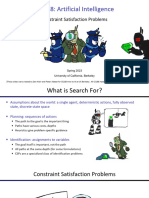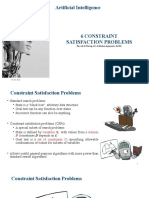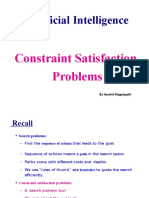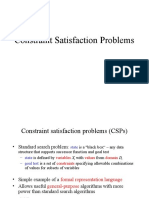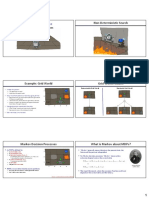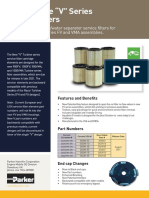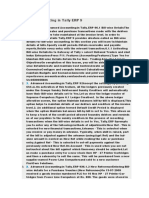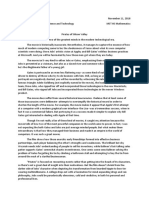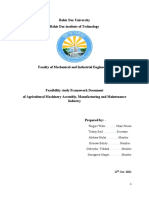Artificial Intelligence
Constraint Satisfaction Problems
What is Search For?
§ Assumptions about the world: a single agent, deterministic actions, fully observed state,
discrete state space
§ Planning: sequences of actions
§ The path to the goal is the important thing
§ Paths have various costs, depths
§ Heuristics give problem-specific guidance
§ Identification: assignments to variables
§ The goal itself is important, not the path
§ All paths at the same depth (for some formulations)
§ CSPs are a specialized class of identification problems
Constraint Satisfaction Problems
Constraint Satisfaction Problems
§ Standard search problems:
§ State is a “black box”: arbitrary data structure
§ Goal test can be any function over states
§ Successor function can also be anything
§ Constraint satisfaction problems (CSPs):
§ A special subset of search problems
§ State is defined by variables Xi with values from a
domain D (sometimes D depends on i)
§ Goal test is a set of constraints specifying allowable
combinations of values for subsets of variables
§ Simple example of a formal representation language
§ Allows useful general-purpose algorithms with more
power than standard search algorithms
CSP Examples
Example: Map Coloring
§ Variables:
§ Domains:
§ Constraints: adjacent regions must have different
colors
Implicit:
Explicit:
§ Solutions are assignments satisfying all
constraints, e.g.:
Example: N-Queens
§ Formulation 1:
§ Variables:
§ Domains:
§ Constraints
Example: N-Queens
§ Formulation 2:
§ Variables:
§ Domains:
§ Constraints:
Implicit:
Explicit:
Constraint Graphs
Constraint Graphs
§ Binary CSP: each constraint relates (at most) two
variables
§ Binary constraint graph: nodes are variables, arcs
show constraints
§ General-purpose CSP algorithms use the graph
structure to speed up search. E.g., Tasmania is an
independent subproblem!
[Demo: CSP applet (made available by aispace.org) -- n-queens]
Screenshot of Demo N-Queens
Example: Cryptarithmetic
§ Variables:
§ Domains:
§ Constraints:
Example: Sudoku
§ Variables:
§ Each (open) square
§ Domains:
§ {1,2,…,9}
§ Constraints:
9-way alldiff for each column
9-way alldiff for each row
9-way alldiff for each region
(or can have a bunch of
pairwise inequality
constraints)
Example: The Waltz Algorithm
§ The Waltz algorithm is for interpreting
line drawings of solid polyhedra as 3D
objects
§ An early example of an AI computation
posed as a CSP
?
§ Approach:
§ Each intersection is a variable
§ Adjacent intersections impose constraints
on each other
§ Solutions are physically realizable 3D
interpretations
Varieties of CSPs and Constraints
Varieties of CSPs
§ Discrete Variables
§ Finite domains
§ Size d means O(dn) complete assignments
§ E.g., Boolean CSPs, including Boolean satisfiability (NP-
complete)
§ Infinite domains (integers, strings, etc.)
§ E.g., job scheduling, variables are start/end times for each job
§ Linear constraints solvable, nonlinear undecidable
§ Continuous variables
§ E.g., start/end times for Hubble Telescope observations
§ Linear constraints solvable in polynomial time by LP methods
Varieties of Constraints
§ Varieties of Constraints
§ Unary constraints involve a single variable (equivalent to
reducing domains), e.g.:
§ Binary constraints involve pairs of variables, e.g.:
§ Higher-order constraints involve 3 or more variables:
e.g., cryptarithmetic column constraints
§ Preferences (soft constraints):
§ E.g., red is better than green
§ Often representable by a cost for each variable assignment
§ Gives constrained optimization problems
§ (We’ll ignore these until we get to Bayes’ nets)
Real-World CSPs
§ Scheduling problems: e.g., when can we all meet?
§ Timetabling problems: e.g., which class is offered when and where?
§ Assignment problems: e.g., who teaches what class
§ Hardware configuration
§ Transportation scheduling
§ Factory scheduling
§ Circuit layout
§ Fault diagnosis
§ … lots more!
§ Many real-world problems involve real-valued variables…
Solving CSPs
Standard Search Formulation
§ Standard search formulation of CSPs
§ States defined by the values assigned
so far (partial assignments)
§ Initial state: the empty assignment, {}
§ Successor function: assign a value to an
unassigned variable
§ Goal test: the current assignment is
complete and satisfies all constraints
§ We’ll start with the straightforward,
naïve approach, then improve it
Search Methods
§ What would BFS do?
§ What would DFS do?
§ What problems does naïve search have?
[Demo: coloring -- dfs]
Video of Demo Coloring -- DFS
Backtracking Search
Backtracking Search
§ Backtracking search is the basic uninformed algorithm for solving CSPs
§ Idea 1: One variable at a time
§ Variable assignments are commutative, so fix ordering
§ I.e., [WA = red then NT = green] same as [NT = green then WA = red]
§ Only need to consider assignments to a single variable at each step
§ Idea 2: Check constraints as you go
§ I.e. consider only values which do not conflict with previous assignments
§ Might have to do some computation to check the constraints
§ “Incremental goal test”
§ Depth-first search with these two improvements
is called backtracking search (not the best name)
§ Can solve n-queens for n 25
Video of Demo Coloring – Backtracking
Backtracking Example
Backtracking Search
§ Backtracking = DFS + variable-ordering + fail-on-violation
§ What are the choice points?
[Demo: coloring -- backtracking]
Improving Backtracking
§ General-purpose ideas give huge gains in speed
§ Ordering:
§ Which variable should be assigned next?
§ In what order should its values be tried?
§ Filtering: Can we detect inevitable failure early?
§ Structure: Can we exploit the problem structure?
Filtering
Filtering: Forward Checking
§ Filtering: Keep track of domains for unassigned variables and cross off bad options
§ Forward checking: Cross off values that violate a constraint when added to the existing
assignment
NT Q
WA
SA NSW
V
[Demo: coloring -- forward checking]
Video of Demo Coloring – Backtracking with Forward Checking
Filtering: Constraint Propagation
§ Forward checking propagates information from assigned to unassigned variables, but
doesn't provide early detection for all failures:
NT Q
WA
SA
NSW
V
§ NT and SA cannot both be blue!
§ Why didn’t we detect this yet?
§ Constraint propagation: reason from constraint to constraint
Consistency of A Single Arc
§ An arc X Y is consistent iff for every x in the tail there is some y in the head which
could be assigned without violating a constraint
NT Q
WA
SA
NSW
V
Delete from the tail!
§ Forward checking: Enforcing consistency of arcs pointing to each new assignment
Arc Consistency of an Entire CSP
§ A simple form of propagation makes sure all arcs are consistent:
NT Q
WA SA
NSW
V
§ Important: If X loses a value, neighbors of X need to be rechecked!
§ Arc consistency detects failure earlier than forward checking
§ Can be run as a preprocessor or after each assignment Remember:
§ What’s the downside of enforcing arc consistency? Delete from
the tail!
Enforcing Arc Consistency in a CSP
§ Runtime: O(n2d3), can be reduced to O(n2d2)
§ … but detecting all possible future problems is NP-hard
[Demo: CSP applet (made available by aispace.org) -- n-queens]
Video of Demo Arc Consistency – CSP Applet – n Queens
Limitations of Arc Consistency
§ After enforcing arc
consistency:
§ Can have one solution left
§ Can have multiple solutions left
§ Can have no solutions left (and
not know it)
§ Arc consistency still runs What went
wrong here?
inside a backtracking search!
[Demo: coloring -- forward checking]
[Demo: coloring -- arc consistency]
Video of Demo Coloring – Backtracking with Forward Checking –
Complex Graph
Video of Demo Coloring – Backtracking with Arc Consistency –
Complex Graph
Ordering
Ordering: Minimum Remaining Values
§ Variable Ordering: Minimum remaining values (MRV):
§ Choose the variable with the fewest legal left values in its domain
§ Why min rather than max?
§ Also called “most constrained variable”
§ “Fail-fast” ordering
Ordering: Least Constraining Value
§ Value Ordering: Least Constraining Value
§ Given a choice of variable, choose the least
constraining value
§ I.e., the one that rules out the fewest values in
the remaining variables
§ Note that it may take some computation to
determine this! (E.g., rerunning filtering)
§ Combining these ordering ideas makes
1000 queens feasible
[Demo: coloring – backtracking + AC + ordering]
Demo: Backtracking + AC + Ordering
Constraint Satisfaction Problems
§ Standard search problems:
§ State is a “black box”: arbitrary data structure
§ Goal test can be any function over states
§ Successor function can also be anything
§ Constraint satisfaction problems (CSPs):
§ A special subset of search problems
§ State is defined by variables Xi with values from a
domain D (sometimes D depends on i)
§ Goal test is a set of constraints specifying allowable
combinations of values for subsets of variables
§ Simple example of a formal representation language
§ Allows useful general-purpose algorithms with more
power than standard search algorithms
Degree Heuristic
§ Tie-breaker among MRV variables
§ Degree heuristic:
§ Choose the variable participating in the most constraints
on remaining variables
§ Why most rather than fewest constraints?
Example: N-Queens
§ Formulation 1.5:
§ Variables:
§ Domains:
§ Constraints:
… there’s an even better way! What is it?
5 Minute Break
Courtesy of Dan Gillick
Waltz on Simple Scenes
§ Assume all objects:
§ Have no shadows or cracks
§ Three-faced vertices
§ “General position”: no junctions
change with small movements of
the eye.
§ Then each line on image is one of
the following:
§ Boundary line (edge of an object)
() with right hand of arrow
denoting “solid” and left hand
denoting “space”
§ Interior convex edge (+)
§ Interior concave edge (-) 49
Legal Junctions
§ Only certain junctions are
physically possible
§ How can we formulate a CSP to
label an image?
§ Variables: vertices
§ Domains: junction labels
§ Constraints: both ends of a line
should have the same label
(x,y) in
y , ,…
50
Improving Backtracking
§ General-purpose ideas can give huge gains in speed:
§ Which variable should be assigned next?
§ In what order should its values be tried?
§ Can we detect inevitable failure early?
§ Can we take advantage of problem structure?
51
Forward Checking
NT Q
WA
SA
NSW
V
§ Idea: Keep track of remaining legal values for unassigned
variables (using immediate constraints)
§ Idea: Terminate when any variable has no legal values
[demo: forward checking animation]
Constraint Propagation
NT Q
WA
SA
NSW
V
§ Forward checking propagates information from assigned to adjacent
unassigned variables, but doesn't detect more distant failures:
§ NT and SA cannot both be blue!
§ Why didn’t we detect this yet?
§ Constraint propagation repeatedly enforces constraints (locally)
Arc Consistency WA
NT
SA
Q
NSW
V
§ Simplest form of propagation makes each arc consistent
§ X Y is consistent iff for every value x there is some allowed y
• If X loses a value, neighbors of X need to be rechecked!
• Arc consistency detects failure earlier than forward checking
• What’s the downside of arc consistency?
• Can be run as a preprocessor or after each assignment
Arc Consistency
§ Runtime: O(n2d3), can be reduced to O(n2d2)
§ … but detecting all possible future problems is NP-hard – why?
55
[demo: arc consistency animation]
Limitations of Arc Consistency
§ After running arc
consistency:
§ Can have one solution left
§ Can have multiple solutions
left
§ Can have no solutions left
(and not know it)







